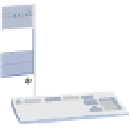Information Technology Reference
In-Depth Information
Computer 1
Figure 3.9
Storag
e dev
ice 1
Storage Area Network
A SAN provides high-speed
connections between data-storage
devices and computers over a
network.
Computer 2
Storage device 2
Storage
area
network
Computer 3
Storage device 3
The Navy's Surface Combat Systems Center in Wallops Island, Virginia, uses a SAN to
Company designs and markets home furnishings and decorative accessories via 422 retail
outlets, catalogs, and the Internet. The firm implemented 1.5 TB of SAN data storage to
effectively hold its inventory data.
33
A fundamental difference between NAS and SAN is that NAS uses file input/output,
which defines data as complete containers of information, while SAN deals with block input/
output, which is based on subsets of data smaller than a file. SAN manufacturers include
EMC, Hitachi Data Systems Corporation, Xiotech, and IBM.
As organizations set up large-scale SANs, they use more computers and network con-
nections, which become difficult to manage. In response, software tools designed to automate
storage using previously defined policies are finding a place in the enterprise. Known as
policy-based storage management
, the software products from industry leaders such as
Veritas Software Corporation, Legato Systems, Inc., EMC, and IBM automatically allocate
storage space to users, balance the loads on servers and disks, and reroute networks when
systems go down—all based on policies set up by system administrators.
The trend in secondary storage is toward higher capacity, increased portability, and au-
tomated storage management. Organizations should select a type of storage based on their
needs and resources. In general, storing large amounts of data and information and providing
users with quick access makes an organization more efficient. Businesses can also choose pay-
per-use services, where they rent space on massive storage devices housed either at a service
provider (e.g., Hewlett-Packard or IBM) or on the customer's premises, paying only for the
amount of storage they use. This approach is sensible for organizations with wildly fluctuating
storage needs, such as those involved in the testing of new drugs or developing software.
policy-based storage
management
Automation of storage using
previously defined policies.
Your first experience with computers is usually through input and output devices. These
devices are the gateways to the computer system—you use them to provide data and in-
structions to the computer and receive results from it. Input and output devices are part of
a computer's user interface, which includes other hardware devices and software that allow
you to interact with a computer system.
As with other computer system components, an organization should keep their business
goals in mind when selecting input and output devices. For example, many restaurant chains











































































































